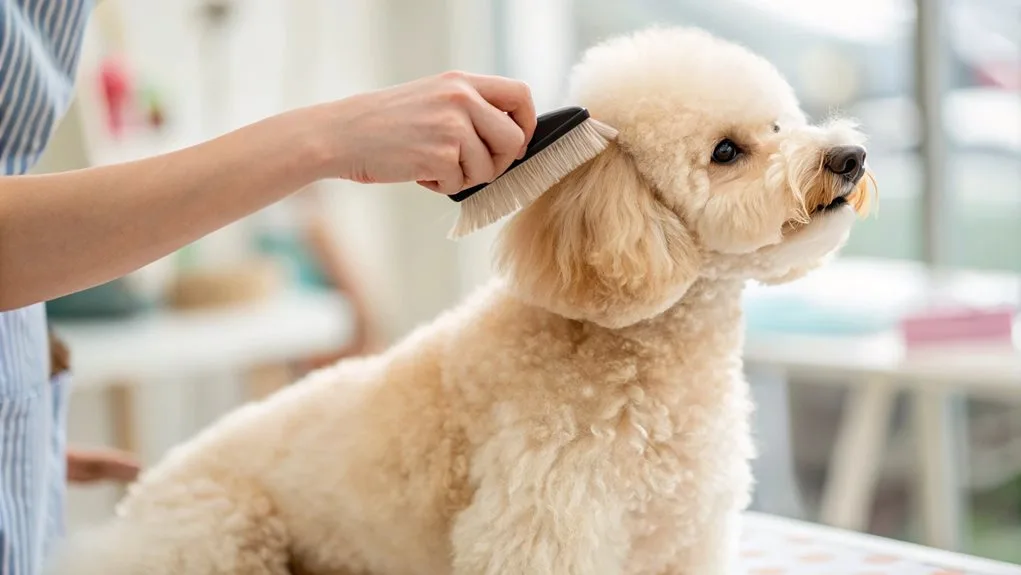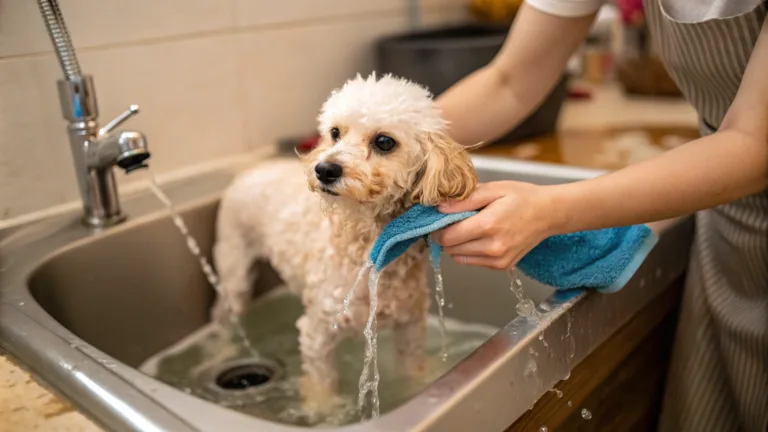Skin Tumors in Toy Poodles: What Owners Should Know

Toy Poodles can develop various skin tumors, with the most common types being lipomas, sebaceous adenomas, and mast cell tumors. Owners should regularly check their poodle’s skin during grooming sessions for unusual lumps, bumps, or changes in skin texture.
Risk factors include age, genetic predisposition, sun exposure, and light-colored coats. Early detection is vital, so monthly skin examinations and proper grooming practices are essential preventive measures.
While some tumors are harmless, others require immediate veterinary attention. Treatment options range from simple monitoring to surgery, depending on the tumor type. Professional veterinary guidance and a proactive approach will help guarantee your Toy Poodle’s long-term skin health.
Key Takeaways
- Toy Poodles are prone to various skin tumors, with lipomas, sebaceous adenomas, and mast cell tumors being the most common types.
- Regular monthly skin examinations during grooming can help detect unusual lumps, persistent scratching, or changes in existing spots early.
- Light-colored or white Toy Poodles have higher skin tumor risks, requiring extra protection from sun exposure and environmental chemicals.
- Diagnostic options include physical exams, imaging tests, and tissue biopsies to determine if tumors are benign or malignant.
- Quick veterinary attention is needed for rapidly growing tumors, bleeding spots, or lumps that interfere with normal activities.
Common Types of Skin Tumors
Several common types of skin tumors affect Toy Poodles, with lipomas, sebaceous adenomas, and mast cell tumors being the most frequently diagnosed. These growths can develop due to a combination of genetic predisposition and environmental influences, making regular skin checks an essential part of pet care.
Lipomas are soft, fatty lumps that develop under the skin and are usually harmless. They’re like small pillows beneath the surface and typically don’t require treatment unless they interfere with movement.
Sebaceous adenomas appear as small, warty growths on the skin’s surface, often developing in middle-aged and older poodles. While unsightly, they’re generally benign and manageable. Their single-layer coat makes it easier to detect these growths during routine grooming sessions.
Mast cell tumors require more attention, as they can be potentially serious. These tumors vary in appearance and might look like raised, red bumps that can change size. Environmental influences, such as sun exposure and certain chemicals, may contribute to tumor development, though genetic factors often play a significant role.
The good news is that early detection through regular grooming and veterinary check-ups helps guarantee successful treatment outcomes for most skin tumors in Toy Poodles. Regular hypoallergenic product usage during bathing can help maintain healthy skin and make abnormal growths easier to detect.
Signs and Warning Signals
Recognizing skin tumors in Toy Poodles starts with understanding their common warning signs. Pet owners should regularly check their dogs for unusual lumps, bumps, or changes in the skin’s texture during grooming sessions. Watch for areas that appear raised, discolored, or different from surrounding skin.
Unlike toy poodle height, which stabilizes by 6-7 months, skin changes can occur throughout their lives. Key warning signals include persistent scratching, licking, or biting at specific spots. Sometimes, environmental exposure to excessive sunlight or certain chemicals can trigger skin changes that warrant attention.
Dietary impact also plays a role – poor nutrition may make dogs more susceptible to skin problems, including tumor development.
Look out for these specific signs: crusty or scaly patches that don’t heal, sudden hair loss around a specific area, bleeding or oozing from skin lesions, and changes in the size or color of existing spots or moles. Small lumps that rapidly grow bigger deserve immediate veterinary attention.
While not every bump means trouble (Toy Poodles can develop harmless fatty deposits), it’s better to err on the side of caution. Regular home checks and prompt veterinary visits for suspicious changes are your best defense against serious skin tumors.
With their 14 to 18 year average lifespan, Toy Poodles require consistent monitoring throughout their lives to catch potential skin issues early.
Risk Factors

Understanding the risk factors for skin tumors in Toy Poodles boils down to both genetic and environmental influences. The genetic predisposition in these small, beloved companions plays a significant role, as certain bloodlines may carry a higher likelihood of developing skin tumors.
Age is another vital factor, with older Toy Poodles being more susceptible to tumor development. Light-colored or white-coated Poodles face increased risk due to their sensitive skin.
Environmental exposure to harmful elements like excessive UV radiation, certain chemicals, and pollutants can trigger tumor formation. Regular exposure to direct sunlight without protection is particularly concerning for these delicate dogs.
Other risk factors include hormonal imbalances, compromised immune systems, and previous skin injuries that didn’t heal properly. Notably, females may have a slightly higher predisposition to certain types of skin tumors.
Poor nutrition and obesity can also contribute to increased risk. The good news is that many of these risk factors can be managed through proper care, regular veterinary check-ups, and mindful lifestyle choices. While we can’t change genetics, we can certainly work to minimize environmental risks. Professional grooming practices can help monitor and maintain skin health through regular inspections.
Poodles with color dilution genes may be particularly susceptible to skin problems due to their association with color dilution alopecia.
Prevention Measures

Implementing preventive measures substantially reduces the risk of skin tumors in Toy Poodles. Regular monitoring of your pet’s skin condition, combined with proper grooming practices and attention to environmental factors, creates a strong foundation for prevention.
Making smart dietary adjustments, such as incorporating antioxidant-rich foods and maintaining proper nutrition, can strengthen your poodle’s natural defenses against tumor development.
Using conditioning spray treatments before brushing helps maintain healthy skin and coat while preventing irritation that could lead to skin issues.
Key preventive strategies that every Toy Poodle owner should follow include:
- Monthly skin examinations to detect any unusual growths or changes early
- Protection from excessive sun exposure, particularly during peak UV hours
- Regular professional grooming to maintain skin health and spot potential issues
- Use of pet-safe sunscreen on areas with thin fur or exposed skin
Creating a healthy indoor environment is equally important. Minimize exposure to harmful chemicals, including certain cleaning products and pesticides.
When outdoors, avoid areas treated with strong lawn chemicals. Remember that prevention is always easier than treatment, and establishing these healthy habits early in your Toy Poodle’s life can markedly impact their long-term well-being and reduce tumor risks.
Scheduling professional grooming sessions every 4-6 weeks helps maintain optimal skin health while allowing early detection of any concerning changes.
Diagnostic Tests and Procedures

Despite diligent prevention efforts, skin tumors may still develop, making accurate diagnosis paramount for effective treatment. When a suspicious growth is found on a Toy Poodle, veterinarians typically begin with a thorough physical examination, carefully documenting the size, location, and appearance of the mass.
The diagnostic journey usually starts with non-invasive imaging techniques, such as ultrasound or radiographs, which help determine the tumor’s depth and whether it has spread to other areas.
For more detailed visualization, veterinarians might recommend advanced imaging like CT scans or MRI, especially for complex cases. The most definitive diagnostic tool, however, is histopathology analysis, where a small tissue sample is extracted through fine-needle aspiration or biopsy.
In the laboratory, pathologists examine these samples under microscopes to identify the tumor type and determine if it’s benign or malignant. This vital information guides the treatment plan and helps predict the outcome. Professional groomers can assist in early detection of lumps during regular grooming sessions.
Sometimes, additional blood tests and lymph node evaluations are necessary to create a complete picture of your poodle’s health status. Remember, early detection through regular check-ups often leads to better treatment outcomes.
Regular monitoring should include checking for any unusual ear odors, which can indicate underlying health issues that may affect tumor development.
Treatment Options
Treatment strategies for skin tumors in Toy Poodles vary substantially based on the tumor type, size, location, and stage of progression. Veterinarians typically develop customized treatment plans that may combine multiple approaches for the best possible outcome.
Modern veterinary medicine offers several effective options, including surgical removal, laser therapy, and innovative immunotherapy treatments.
When treating skin tumors in Toy Poodles, veterinarians consider these key factors:
- The overall health and age of the dog, which affects treatment tolerance
- The potential for tumor recurrence and need for follow-up care
- The cosmetic outcome, especially for tumors on visible areas
- The cost and availability of different treatment options
Surgical removal remains the most common treatment choice, but laser therapy has gained popularity for its precision and reduced healing time. Immunotherapy shows promising results in certain cases, helping boost the dog’s natural defense system against cancer cells.
Some Toy Poodles may benefit from combination treatments, such as surgery followed by targeted therapy. Regular monitoring and adjusting the treatment plan as needed helps guarantee the best possible outcome for these beloved pets.
Post-Treatment Care
Successful recovery from skin tumor treatment depends heavily on proper post-treatment care for Toy Poodles. Following surgery or other treatments, owners must carefully monitor their pet’s healing process and follow all veterinary instructions precisely.
Proper wound management is essential to prevent infection and promote healing, which typically involves keeping the surgical site clean and dry.
Your veterinarian will provide specific guidelines for pain control and medication schedules. Most Toy Poodles recover comfortably at home with prescribed pain medications and anti-inflammatory drugs.
It’s important to prevent your pup from scratching or licking the treatment area – yes, that might mean wearing the “cone of shame” for a while. Regular monitoring of the surgical site for signs of redness, swelling, or discharge is vital.
Activity should be limited during the recovery period, with short, gentle walks replacing regular exercise routines. Keep your Toy Poodle’s sleeping area clean and comfortable, and maintain regular feeding schedules.
Most importantly, attend all follow-up appointments to guarantee proper healing and catch any potential complications early. With diligent care, most Toy Poodles return to their bouncy, playful selves within a few weeks.
Regular Monitoring Guidelines
In line with preventive healthcare practices, implementing a consistent monitoring routine is essential for Toy Poodle owners to detect skin tumors early. Through proper owner education and regular veterinary collaboration, families can establish an effective monitoring schedule that helps catch potential issues before they become serious concerns.
Regular monitoring should include monthly at-home skin checks and scheduled veterinary visits. During these checks, owners should pay special attention to any changes in their Toy Poodle’s skin, documenting new growths or changes in existing ones.
Taking photos can help track changes over time and share information with your veterinarian.
- Conduct thorough skin checks while grooming, focusing on areas under the fur
- Document size, color, and texture of any suspicious spots using a monitoring journal
- Take clear photos of concerning areas every two weeks if changes are noticed
- Schedule veterinary check-ups every six months, or more frequently for dogs with previous tumors
Early detection through consistent monitoring substantially improves treatment outcomes. By working closely with your veterinarian and maintaining detailed records, you’ll be better equipped to protect your Toy Poodle’s health and guarantee prompt medical intervention when needed.
When to Seek Emergency Care
Recognizing urgent warning signs is crucial when monitoring skin tumors in Toy Poodles, as certain symptoms require immediate veterinary attention.
Emergency symptoms that warrant an urgent consultation include rapid tumor growth, bleeding that won’t stop, changes in tumor color or texture, and signs that the mass has become painful to your pet.
If you notice your Toy Poodle excessively licking or scratching at the tumor site, or if the area becomes hot to the touch and shows signs of infection, don’t wait for a regular check-up.
Additionally, seek immediate care if the tumor begins to interfere with your dog’s normal activities, such as walking, eating, or lying down comfortably.
Any sudden changes in your pet’s energy level or appetite, especially when accompanied by tumor changes, should prompt a quick trip to the vet.
Conclusion
Early detection and proper veterinary care remain vital factors in managing skin tumors in toy poodles. Regular monitoring, preventive measures, and swift response to warning signs substantially improve outcomes. With appropriate treatment options and dedicated post-treatment care, many skin tumors can be successfully managed. Through consistent checkups and awareness of risk factors, toy poodle owners can help guarantee their pets maintain healthy, tumor-free skin throughout their lives.






